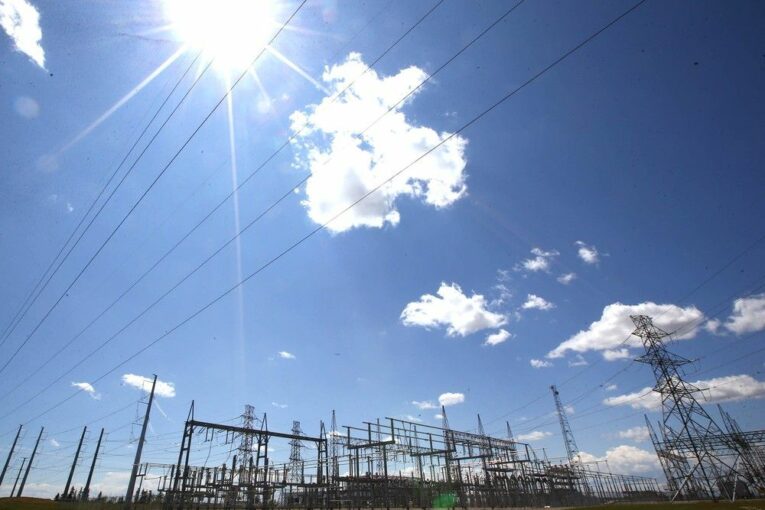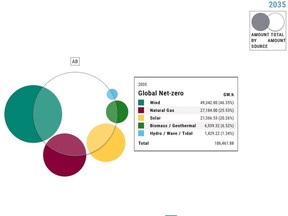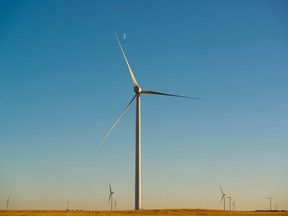
[ad_1]
What does Alberta’s power grid look like in 2035 in a net-zero universe?
It’s windy, with a fair bit of sunshine. And it’s a lot less gassy.
A new report by the Canada Energy Regulator (CER) examines what a net-zero future could look like for the country — and the provinces — by modelling electricity generation over the next three decades, including 2035.
That’s the year Ottawa has earmarked for the electricity grid to reach the net-zero target.
In Alberta, renewable energy would make up two-thirds of power generation by that time, up from about 15 per cent in 2022, under a scenario where countries around the world take action to limit global warming to 1.5 degree Celsius.
Wind would provide up to 46 per cent of all generation in this province, while solar reaches 20 per cent, according to the CER. About one-quarter of all power generation in Alberta would still come from natural gas by 2035, down from more than 60 per cent last year.
It’s one of three scenarios the regulator examined. Another model that shows Canada moving to net zero while other countries lag behind, pegs renewables in Alberta making up more than 70 per cent of electrical generation.

It’s not meant to be a crystal ball, although it highlights the transformation required to a provincial power grid that relies heavily on fossil fuels today to keep the lights on.
“For the provinces that rely on unabated fossil fuel right now for electricity generations, it’s about introducing a lot more wind power, to some extent solar, but essentially, it’s about renewable energy,” said CER chief economist Jean-Denis Charlebois.
The report states that wind power contributes the most amount of new generation in the country by 2050, increasing nine-fold from current levels — under the global net-zero scenario — with large growth projected in Alberta, Saskatchewan, British Columbia and Ontario.
Under this case, natural gas-fired power generation paired with carbon capture and storage (CCUS) projects — to sequester the emissions — becomes a key source of electricity in Alberta and Saskatchewan, making up 13 per cent of total generation by 2050.
“It shows the extent of the additional building that will be required, which will mean money, it will mean a lot of infrastructure, it will mean a lot of regulatory approvals,” said Marla Orenstein, director of the Natural Resources Centre at the Canada West Foundation.
“Looking at 2035, it estimates almost half of Alberta’s electricity would have to be provided by wind. I can’t see how, under any circumstance, that is feasible … It’s a good indication of the size of the hurdles that we face.”
On the political front, the drive to shift the electricity grid to net-zero emission by 2035 has triggered a donnybrook between the Trudeau government and Alberta and Saskatchewan.
Premier Danielle Smith maintains it would be unrealistic and expensive to reach the target in a dozen years, given the sheer scale of investments required — up to $52 billion, according to an Alberta Electric System Operator report.
Not all provinces are facing the same degree of difficulty in this decarbonization puzzle, thanks to the resources at their disposal, such as the availability of hydro in British Columbia, Quebec and Manitoba.
In Alberta and Saskatchewan, major investments will likely be needed in carbon capture and storage, tied to gas-fired generation.
“Natural gas with CCUS is a flexible source of power, meaning it plays an important role in balancing electricity systems, particularly those that do not have many other flexible options,” the report states.

While more renewable power is coming online, such generation is tied to the wind actually blowing and the sun shining. It needs to be balanced with other generation sources, storage technologies (such as pumped hydro or battery storage), and by imports from other jurisdictions.
“It shows that we need to decarbonize our grid rapidly because the rest of the economy depends on it. And it also shows that we can actually do this in a reliable manner,” said Binnu Jeyakumar, director of electricity at the Pembina Institute.
“Alberta is currently the Canadian leader in terms of building wind energy, as well as solar energy. So, those are technologies we know we can deploy in Alberta.”
Yet, the province needs to provide some certainty of getting to net-zero as investments will be required for new generation and infrastructure, such as in transmission interties between provinces, she added.
Costs are another key consideration.
However, a report issued Thursday by the Canadian Climate Institute estimates the average household in the country by 2050 will pay 12 per cent less for energy than today because of improved energy efficiency, thanks to technologies such as heat pumps and electric vehicles.
It noted the federal government’s incentives to promote clean energy will provide billions of dollars, and provinces that rely on fossil fuels — including Alberta — will get more support.
But Dustin Owens, managing director of government and regulatory policy at Heartland Generation, one of the province’s largest generators, equates the evolution of the grid to building a tower of wooden blocks.
More pieces will be needed at the top as electricity demand keeps growing.
However, policymakers also need to be careful about preserving the base, keeping reliability and affordability in the picture.
“I like to think of it as a Jenga set. And we’re looking to add to the Jenga set, to make it grow,” said Owens, who’s also chair of the Independent Power Producers Society of Alberta.
“If we pull too many Jenga blocks at the very bottom right away, I worry that you could topple the Jenga set over.”
Chris Varcoe is a Calgary Herald columnist.
[ad_2]
You can read more of the news on source
